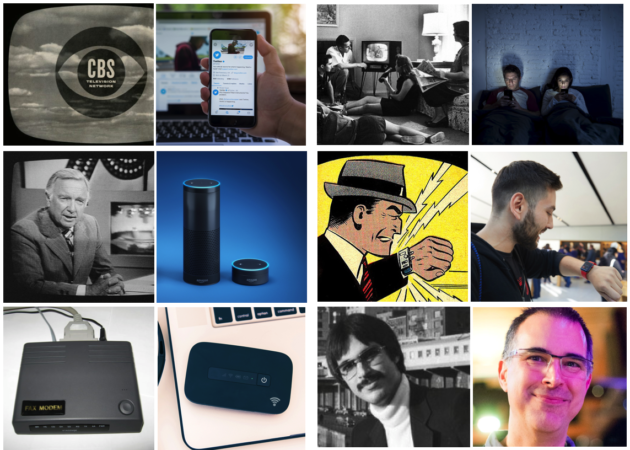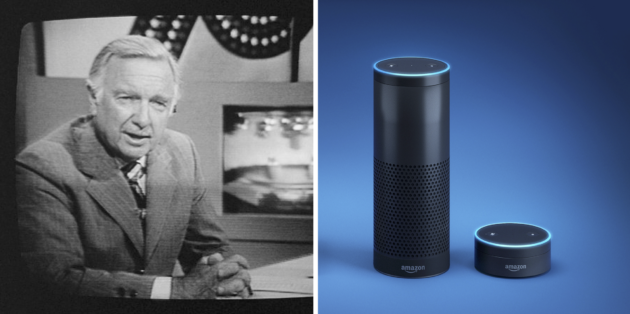
In digital tech, 25 years is more than just a generation. It is an epoch. In pre-iPhonic 1992, there was no graphical web browser, no Amazon or Google, and no dot-com bubble.
RELATED: Public radio’s digital moment: Smartphones, streaming, and the future of listening
But there was one fool who thought he could forecast the future of how we’d get news and information. It was me, in a Seattle Times essay, published on Wednesday, Oct. 7, 1992. At the time, I had spent a dozen years as a broadcaster, written science fiction, and recently moved into tech, which gave me unique insight into the media industry and the massive change to come. Or so I thought.
After two-and-a-half decades of innovation and upheaval, I’ve been looking back at my predictions. As you read on, you’ll see what I wrote back then, and my thoughts today on what I got right and wrong. It’s a window (or, perhaps, a screen) into the incredible change we’ve all experienced.

1992 Prediction: Right now, the networks (ABC, CBS, and NBC) and the news wire services (Reuters, AP and UPI) are news “distributors.” They get news and distribute it to TV/radio stations and newspapers. But the dominance of these mammoths is fading.
2017 Take: I’ll take this as a strong start. Maybe it seems obvious in retrospect, but this was before the graphical web browser, which wasn’t introduced for another year. Now, 25 years later, the web, social media, smartphones, mobile connectivity and voice-enabled assistants have completely changed the way news is distributed, and by whom.
It’s worth noting that NPR and PBS were not nearly as prominent then. And Fox? It was a young, six-year-old entertainment network.
1992 Prediction: Consider: It’s possible, today, for anyone to buy an hour of audio satellite time for a mere $60. Cable systems have added lots of channels, such as “narrowcasters” CNN and MTV. Incredibly cheap and powerful personal computers speed print and graphics production.
At first, these technological changes simply made it easier and cheaper for the mammoths to gather and distribute information. But local stations and newspapers soon realized they could use the same techniques.
When a major earthquake hit Mexico City in 1985, a number of broadcast stations pooled resources, bought satellite time, and formed ad hoc “networks” to cover the disaster, sending back customized information to each station. These ad hoc networks have since sprung up for major stories ranging from the Berlin Wall dismantling to Operation Desert Storm.
2017 Take: I totally missed how the internet would become the new ad hoc network enabler and let almost anyone create a distribution network. These networks were fed by smaller and even more ‘personal’ computers, from laptops to tablets to smartphones. Plus WiFi, Bluetooth and 4G cellular data made it easier to be mobile. Yes, back then, the internet was mostly used by government, researchers and academia, and WiFi didn’t exist. But I still blew this one.

1992 Prediction: Even the average news consumer is bypassing the traditional news distribution channels. During the 1989 San Francisco earthquake, computer bulletin board systems like Prodigy and CompuServe became informal information clearing houses. Those inside the earthquake zone posted information about casualties and damage on these commercial information services, accessible by anyone with a PC and a modem. These and similar services let subscribers directly browse news from AP, UPI, Reuters and other traditional news sources every day, as well as trade information with each other.
This information revolution is so pervasive it’s ironically easy to overlook. Cellular telephones let anyone in a car be a radio traffic reporter. Video camcorders made it possible for a bystander to capture the police beating of Rodney King in Los Angeles.
And more is on the way. If the networks don’t like what cable has done to TV, wait until they see what Digital Audio Broadcast will do to radio. Later this decade, DAB will deliver CD-quality audio from a satellite or tower to your car or home. Thanks to its ability to have several “channels” of programming embedded in one stream of data, there will be few practical limits to the number of DAB stations.
2017 Take: Both a hit and a miss. DAB is used in 37 countries now, but never took off in the US — we got lame HD Radio, pricey Sirius XM satellite broadcasts, and lots of solid internet streams. Today that average consumer news gathering equipment is called a “smartphone.” But the informal information clearing house role has gone mainstream, as Facebook and Twitter have the reach Prodigy and CompuServe hoped for.
(I do get nostalgic for the sound of modems, though: Beeeep…chhhhhhhhhh…squeeeeeeee!)

1992 Prediction: With this stream of information sources, how will you pan for what’s important to you? You’ll buy yourself an editor.
It’s not like the Washington Post’s Ben Bradlee is going to appear on your doorstep. But the rapid development of inexpensive “fuzzy logic” microprocessors should allow news-sorting smart filters to start showing up in information appliances by the year 2000.
For example, you’re in your car, listening to your favorite DAB station. The smart filter in your radio scans all the incoming channels for any mention of the words “traffic” and “Interstate 5” and automatically flips to the traffic report, using digital delay to make sure you hear all of it.
Or you’re at home. You’ve programmed the smart filter in your PC/TV to scan the electronic version of your daily paper, video/audio channels, on-line computer services, and the PTA newsletter. You’ve told it to rank the items based on key words (such as “sex,” “drugs,” and “rock n’ roll”) and on distance from where you live, and to keep the entire newscast under 30 minutes. You’ve also told it to keep related stories available, just in case you want additional information. If you’re on the road, you can have the same newscast bounced off of a satellite to your portable digital pager/videophone.
Say you don’t want to have to program a smart filter. Then visit your appliance store and buy any of several preprogrammed models. There will be the equivalent of the Peter Jennings model, the Walter Cronkite model, and if you have a fondness for sweaters, the Dan Rather model. There’s no reason these editors have to be based on the judgments of living — or even real — people. A Martin Luther model might seek stories with religious significance, while a Jean-Luc Picard filter could search for news about where no one has gone before.
2017 Take: Still developing, but directionally correct. “Smart filters” sound like customizing Google News or an Alexa Flash Briefing, or even a number of algorithmic recommendation engines. But the big difference is little of it wound up being tied to a specific device — individual preferences are portable, following us to whatever device we have, wherever we are. The fictional filter idea, though, has not yet taken hold (unless you count social media’s “fake news”). And, sadly, those algorithm-driven recommendation engines are often for-profit black boxes, not easily modified by the consumer.

1992 Prediction: But wait. If almost anyone with the right equipment could distribute news, how would you choose a reliable source?
With more people, not fewer, able to access news early in its life cycle, errors may be more quickly corrected than they are now. Market forces may put consistently inaccurate providers out of business. Unless, of course, you want information of a sensational nature. There probably always will be a market for the National Enquirer.
There will be other concerns. Will people hear the things they need to know — like storm warnings? Might not a national government require certain news items get tagged so every filter puts them through? And what happens to copyright protection when the original source is unclear?
2017 Take: I’m screwed. I totally underestimated the power of rumors, and how they could more quickly spread at the speed of computational ‘bots, frustrating the efforts of mere humans to knock them down. I also now realize that we’ve always had information bubbles, from the media people choose to consume to the communities they decide to live in. More tech just makes the bubbles more opaque. Or rose-colored.

1992 Prediction: Problems and all, it’ll be the ultimate freedom of the press: the democratization of information, the ability to choose both sources and “editors” of those sources.
Did you hear that? It sounded like the clatter of a teletype machine – the death throes of the Networkasaurus. But the seeds of its smaller, faster, and more flexible successor are already growing in your personal computer, telephone and cable system.
2017 Take: I definitely nailed the “democratization of information” part. But as in any new democracy, we’ve still learning to be careful about how we vote, in this case with our attention.
Ultimately, 25 years later, I’m reminded that psychology evolves more slowly than technology. For good or ill, human nature triumphs over our tools — and could turn that two-and-a-half decades into an eye-blink, not an epoch, depending on how intelligently we apply tech.
ALSO READ: Move fast and fix things: Why the social web needs to start thinking differently about its products



